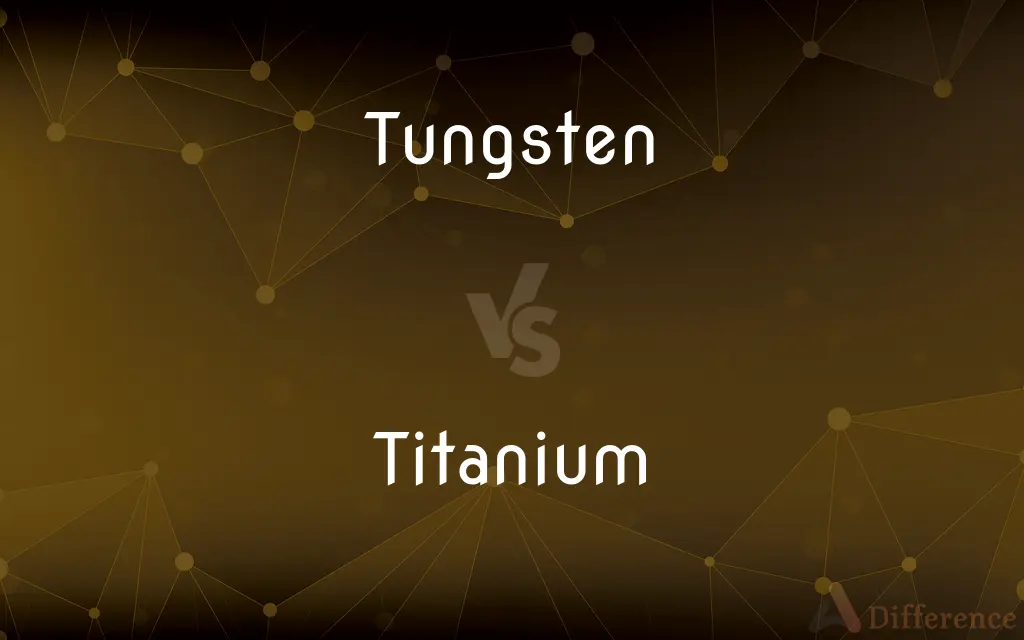Tungsten vs. Titanium — What's the Difference?
By Tayyaba Rehman & Fiza Rafique — Updated on March 21, 2024
Tungsten is known for its high melting point and density, while titanium is renowned for its strength-to-weight ratio and corrosion resistance.

Difference Between Tungsten and Titanium
Table of Contents
ADVERTISEMENT
Key Differences
Tungsten, with the highest melting point of all metals, is extremely dense and hard, making it ideal for applications requiring high temperature resistance and durability, such as in light bulb filaments and heavy metal alloys. Titanium, on the other hand, is significantly lighter and known for its exceptional strength-to-weight ratio, which, combined with its resistance to corrosion, makes it a preferred material in aerospace, medical implants, and sports equipment.
While both metals are used in manufacturing and technology, their distinct properties cater to different requirements. Tungsten's substantial weight and high melting point make it less suitable for applications where weight is a critical factor, such as in aircraft construction. Titanium's lower density and high resistance to corrosion give it an advantage in environments where strength, low weight, and longevity are paramount.
In terms of availability and cost, titanium, though abundant, is costly to extract and process, making it more expensive than many metals, though not necessarily more so than tungsten, which is also expensive due to its complex processing requirements. This cost factor influences their use in various industries, with each metal being selected based on the specific balance of properties and cost-effectiveness required for the application.
On a molecular level, tungsten's exceptional heat and electrical conductivity find uses in electronics and electrical applications, whereas titanium's biocompatibility and non-toxicity make it suitable for medical implants and prosthetics. These contrasting characteristics highlight the diverse applications of these metals based on their unique physical and chemical properties.
Comparison Chart
Melting Point
Highest of all metals, around 3422°C (6192°F).
High, but lower than tungsten, at 1668°C (3034°F).
ADVERTISEMENT
Density
Very high, approximately 19.25 g/cm³.
Lower, about 4.5 g/cm³.
Strength-to-Weight Ratio
Lower compared to titanium.
Exceptionally high, ideal for aerospace and lightweight applications.
Corrosion Resistance
Good, but can oxidize at high temperatures.
Excellent, highly resistant to corrosion by sea water and chlorine.
Applications
Light bulb filaments, heavy metal alloys, mining tools.
Aerospace, medical implants, sports equipment, marine hardware.
Cost and Availability
Expensive due to complex processing; relatively abundant.
Also expensive due to costly extraction and processing; abundant in Earth's crust.
Conductivity
High thermal and electrical conductivity.
Lower thermal and electrical conductivity compared to tungsten.
Biocompatibility
Not commonly used in applications requiring biocompatibility.
Highly biocompatible, making it suitable for medical applications.
Compare with Definitions
Tungsten
A chemical element with high melting point and density, symbol W.
Tungsten filaments are used in incandescent light bulbs for their ability to withstand high temperatures.
Titanium
A strong, lightweight metal known for its corrosion resistance, symbol Ti.
Titanium alloys are used in aircraft structures and engines for their high strength-to-weight ratio.
Tungsten
Utilized in electronics and electrical applications.
Tungsten is used in the production of X-ray tubes and as electrodes in TIG welding.
Titanium
Widely used in medical implants and prosthetics.
Titanium's biocompatibility makes it ideal for hip and knee replacements.
Tungsten
Can be alloyed with other metals to improve their properties.
Tungsten alloys are used in aerospace and automotive industries for their high density and strength.
Titanium
Employed in sports equipment manufacturing.
Titanium is used in golf clubs and bicycle frames for its lightweight and strength.
Tungsten
Known for its robustness and heavy weight.
Tungsten carbide is used in mining equipment due to its extreme hardness and wear resistance.
Titanium
Important in marine applications due to its resistance to sea water corrosion.
Titanium is used in shipbuilding, particularly for submarines and other high-endurance sea vessels.
Tungsten
Tungsten, or wolfram, is a chemical element with the symbol W and atomic number 74. Tungsten is a rare metal found naturally on Earth almost exclusively as compounds with other elements.
Titanium
Titanium is a chemical element with the symbol Ti and atomic number 22. Its atomic weight is 47.867 measured in daltons.
Tungsten
A hard, brittle, corrosion-resistant, gray to white metallic element extracted from wolframite, scheelite, and other minerals, having the highest melting point and lowest vapor pressure of any metal. Tungsten and its alloys are used in high-temperature structural materials and wear-resistant tools and machine parts; in electrical elements, notably lamp filaments; and in instruments requiring thermally compatible glass-to-metal seals. Atomic number 74; atomic weight 183.84; melting point 3,422°C; boiling point 5,555°C; specific gravity 19.3 (20°C); valence 2, 3, 4, 5, 6. Also called wolfram. See Periodic Table.
Titanium
A strong, low-density, highly corrosion-resistant, lustrous white metallic element that occurs widely in igneous rocks and is used to alloy aircraft metals for low weight, strength, and high-temperature stability. Atomic number 22; atomic weight 47.87; melting point 1,668°C; boiling point 3,287°C; specific gravity 4.51; valence 2, 3, 4. See Periodic Table.
Tungsten
A rare metallic chemical element (symbol W, from Latin wolframium) with an atomic number of 74.
Titanium
A chemical element, atomic number 22; it is a strong, corrosion-resistant transition metal, used to make light alloys for aircraft etc.
Tungsten
A light bulb containing tungsten.
Titanium
(countable) A single atom of this element.
Tungsten
Scheelite, calcium tungstate
Titanium
An elementary substance found combined in the minerals manaccanite, rutile, sphene, etc., and isolated as an infusible iron-gray amorphous powder, having a metallic luster. It burns when heated in the air. Symbol Ti. Atomic weight 48.1.
Tungsten
A rare element of the chromium group found in certain minerals, as wolfram and scheelite, and isolated as a heavy steel-gray metal which is very hard and infusible. It has both acid and basic properties. When alloyed in small quantities with steel, it greatly increases its hardness. Symbol W (Wolframium). Atomic weight, 183.6. Specific gravity, 18.
Titanium
A light strong gray lustrous corrosion-resistant metallic element used in strong light-weight alloys (as for airplane parts); the main sources are rutile and ilmenite
Tungsten
Scheelite, or calcium tungstate.
Tungsten
A heavy gray-white metallic element; the pure form is used mainly in electrical applications; it is found in several ores including wolframite and scheelite
Common Curiosities
How do the densities of tungsten and titanium compare?
Tungsten is significantly denser than titanium, making it suitable for applications where weight is less of a concern.
Can tungsten and titanium be used interchangeably?
Due to their distinct properties, they are chosen for specific applications where those properties are advantageous, making them not generally interchangeable.
Why is tungsten used in light bulbs?
Tungsten's high melting point allows it to withstand the high temperatures required to produce light without melting.
Are there any health risks associated with using these metals?
Both metals are generally considered safe, but tungsten has limited use in applications requiring biocompatibility, unlike titanium, which is widely used in medical implants.
What role does tungsten play in electronics?
Its high thermal and electrical conductivity make tungsten valuable in electronic and electrical applications, including as electrodes and in electrical contacts.
What makes titanium suitable for aerospace applications?
Its high strength-to-weight ratio and corrosion resistance make it ideal for aircraft structures where weight and durability are crucial.
Why is titanium more expensive than some other metals?
The extraction and processing of titanium from its ores are complex and costly, contributing to its higher price.
What advancements are being made in the use of tungsten and titanium?
Research continues to explore new alloys and composites to enhance their properties and applications, including in high-temperature environments for tungsten and in additive manufacturing for titanium.
How does the corrosion resistance of titanium compare to other metals?
Titanium is among the most corrosion-resistant metals, particularly against chlorine and sea water, making it superior in marine and chemical processing applications.
Is titanium environmentally friendly?
Titanium is considered relatively environmentally friendly due to its abundance and the non-toxic nature of its corrosion-resistant oxide layer.
Share Your Discovery

Previous Comparison
Totality vs. Totally
Next Comparison
Practice vs. DisciplineAuthor Spotlight
Written by
Tayyaba RehmanTayyaba Rehman is a distinguished writer, currently serving as a primary contributor to askdifference.com. As a researcher in semantics and etymology, Tayyaba's passion for the complexity of languages and their distinctions has found a perfect home on the platform. Tayyaba delves into the intricacies of language, distinguishing between commonly confused words and phrases, thereby providing clarity for readers worldwide.
Co-written by
Fiza RafiqueFiza Rafique is a skilled content writer at AskDifference.com, where she meticulously refines and enhances written pieces. Drawing from her vast editorial expertise, Fiza ensures clarity, accuracy, and precision in every article. Passionate about language, she continually seeks to elevate the quality of content for readers worldwide.
















































